Page 101 of 460

To use these locks, do the following:
1. Insert the key into the security lock slot and
turn it so the slot is in the horizontal position.
2. Close the door.
3. Do the same for the other rear door.
When you want to open a rear door when the
security lock is on, do the following:
1. Unlock the door using the remote keyless
entry transmitter, if the vehicle has one, the
power door lock switch, or by lifting the
rear door manual lock.
2. Open the door from the outside.
To cancel the rear door security lock, do the
following:
1. Unlock the door and open it from the outside.
2. Insert the key into the security lock slot
and turn it so the slot is in the vertical position.
3. Do the same for the other rear door.Lockout Protection
This feature helps prevent you from locking the
doors while your key is in the ignition. Always
remember to take your key with you when exiting
your vehicle.
If the lock switch is pressed on the door that is
open and the key is in the ignition, all of the doors
will lock and then the driver’s door will unlock.
A chime will sound continuously until all doors are
closed.
101
Page 103 of 460

Trunk Release
To open the trunk from the outside, press the
open trunk button on the remote keyless entry
transmitter, if equipped.
Remote Trunk Release
You can also open the trunk from inside the
vehicle.
G(Remote Trunk Release):Press the button
with the open trunk symbol on it. The button is
located next to the exterior lamps control on
the left side of the instrument panel. The shift lever
must be in PARK (P) for the remote trunk
release button to work.
If your vehicle ever loses power, you can open the
trunk by lowering the rear seat and pulling the
emergency trunk release handle located inside the
trunk. SeeSplit Folding Rear Seat on page 15
and “Emergency Trunk Release Handle” following.
Emergency Trunk Release Handle
Notice:Do not use the emergency trunk
release handle as a tie-down or anchor point
when securing items in the trunk as it could
damage the handle. The emergency trunk
release handle is only intended to aid a person
trapped in a latched trunk, enabling them to
open the trunk from the inside.
There is a glow-in-the-dark trunk release handle
located on the latch inside the trunk. This handle
will glow following exposure to light. Pull the release
handle to open the trunk from the inside.
103
Page 105 of 460
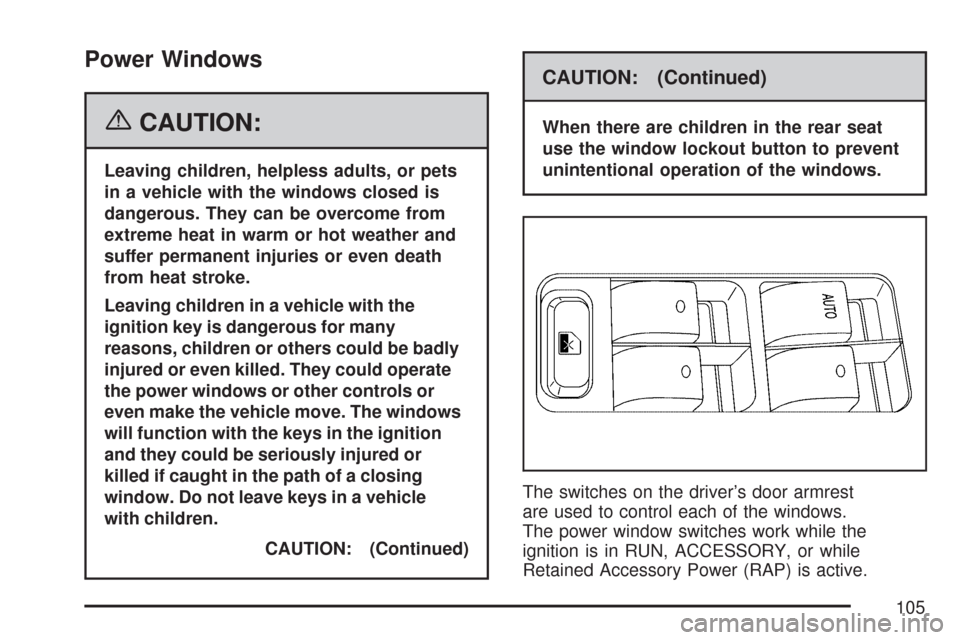
Power Windows
{CAUTION:
Leaving children, helpless adults, or pets
in a vehicle with the windows closed is
dangerous. They can be overcome from
extreme heat in warm or hot weather and
suffer permanent injuries or even death
from heat stroke.
Leaving children in a vehicle with the
ignition key is dangerous for many
reasons, children or others could be badly
injured or even killed. They could operate
the power windows or other controls or
even make the vehicle move. The windows
will function with the keys in the ignition
and they could be seriously injured or
killed if caught in the path of a closing
window. Do not leave keys in a vehicle
with children.
CAUTION: (Continued)
CAUTION: (Continued)
When there are children in the rear seat
use the window lockout button to prevent
unintentional operation of the windows.
The switches on the driver’s door armrest
are used to control each of the windows.
The power window switches work while the
ignition is in RUN, ACCESSORY, or while
Retained Accessory Power (RAP) is active.
105
Page 107 of 460
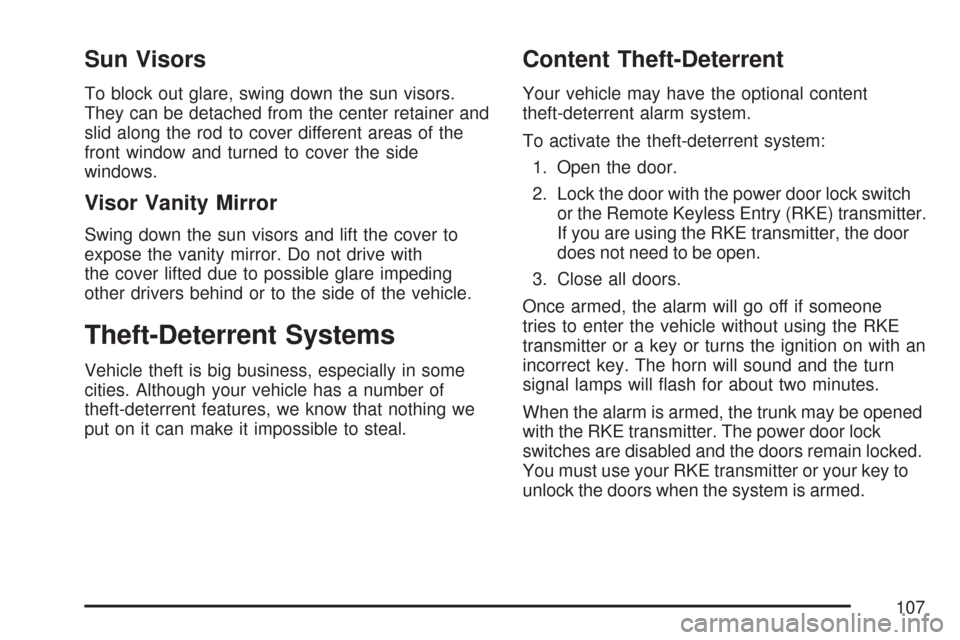
Sun Visors
To block out glare, swing down the sun visors.
They can be detached from the center retainer and
slid along the rod to cover different areas of the
front window and turned to cover the side
windows.
Visor Vanity Mirror
Swing down the sun visors and lift the cover to
expose the vanity mirror. Do not drive with
the cover lifted due to possible glare impeding
other drivers behind or to the side of the vehicle.
Theft-Deterrent Systems
Vehicle theft is big business, especially in some
cities. Although your vehicle has a number of
theft-deterrent features, we know that nothing we
put on it can make it impossible to steal.
Content Theft-Deterrent
Your vehicle may have the optional content
theft-deterrent alarm system.
To activate the theft-deterrent system:
1. Open the door.
2. Lock the door with the power door lock switch
or the Remote Keyless Entry (RKE) transmitter.
If you are using the RKE transmitter, the door
does not need to be open.
3. Close all doors.
Once armed, the alarm will go off if someone
tries to enter the vehicle without using the RKE
transmitter or a key or turns the ignition on with an
incorrect key. The horn will sound and the turn
signal lamps will �ash for about two minutes.
When the alarm is armed, the trunk may be opened
with the RKE transmitter. The power door lock
switches are disabled and the doors remain locked.
You must use your RKE transmitter or your key to
unlock the doors when the system is armed.
107
Page 108 of 460
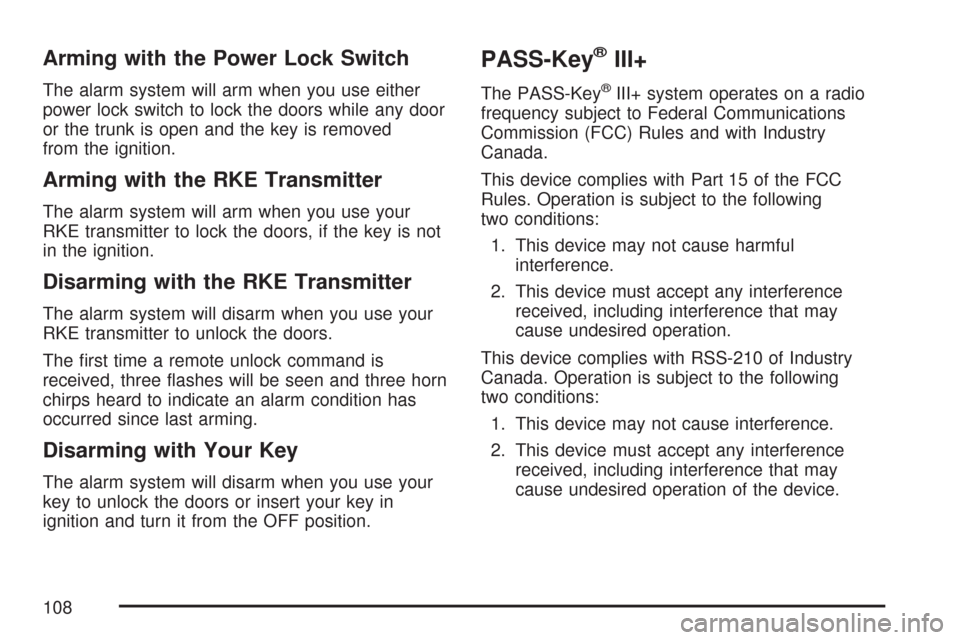
Arming with the Power Lock Switch
The alarm system will arm when you use either
power lock switch to lock the doors while any door
or the trunk is open and the key is removed
from the ignition.
Arming with the RKE Transmitter
The alarm system will arm when you use your
RKE transmitter to lock the doors, if the key is not
in the ignition.
Disarming with the RKE Transmitter
The alarm system will disarm when you use your
RKE transmitter to unlock the doors.
The �rst time a remote unlock command is
received, three �ashes will be seen and three horn
chirps heard to indicate an alarm condition has
occurred since last arming.
Disarming with Your Key
The alarm system will disarm when you use your
key to unlock the doors or insert your key in
ignition and turn it from the OFF position.
PASS-Key®III+
The PASS-Key®III+ system operates on a radio
frequency subject to Federal Communications
Commission (FCC) Rules and with Industry
Canada.
This device complies with Part 15 of the FCC
Rules. Operation is subject to the following
two conditions:
1. This device may not cause harmful
interference.
2. This device must accept any interference
received, including interference that may
cause undesired operation.
This device complies with RSS-210 of Industry
Canada. Operation is subject to the following
two conditions:
1. This device may not cause interference.
2. This device must accept any interference
received, including interference that may
cause undesired operation of the device.
108
Page 109 of 460

Changes or modi�cations to this system by other
than an authorized service facility could void
authorization to use this equipment.
PASS-Key
®III+ uses a radio frequency
transponder in the key that matches a decoder in
your vehicle.
PASS-Key®III+ Operation
Your vehicle has PASS-Key®III+ (Personalized
Automotive Security System) theft-deterrent
system. PASS-Key
®III+ is a passive theft-deterrent
system. This means you do not have to do anything
special to arm or disarm the system. It works when
you transition the key to RUN, ACCESSORY or
START from the OFF position.
When the PASS-Key
®III+ system senses that
someone is using the wrong key, it prevents
the vehicle from starting. Anyone using a
trial-and-error method to start the vehicle will
be discouraged because of the high number
of electrical key codes.If the engine does not start and the security light on
the instrument panel cluster comes on when trying
to start the vehicle, the key may have a damaged
transponder. Turn the ignition off and try again.
If the engine still does not start, and the key
appears to be undamaged, try another ignition key.
At this time, you may also want to check the fuse,
seeFuses and Circuit Breakers on page 398.Ifthe
engine still does not start with the other key, your
vehicle needs service. If your vehicle does start, the
�rst key may be faulty. See your dealer/retailer who
can service the PASS-Key
®III+ to have a new key
made. In an emergency, contact Roadside
Assistance.
It is possible for the PASS-Key
®III+ decoder
to learn the transponder value of a new or
replacement key. Up to nine additional keys may
be programmed for the vehicle. The following
procedure is for programming additional keys only.
If all the currently programmed keys are lost or do
not operate, you must see your dealer/retailer or a
locksmith who can service PASS-Key
®III+ to have
keys made and programmed to the system.
109
Page 110 of 460
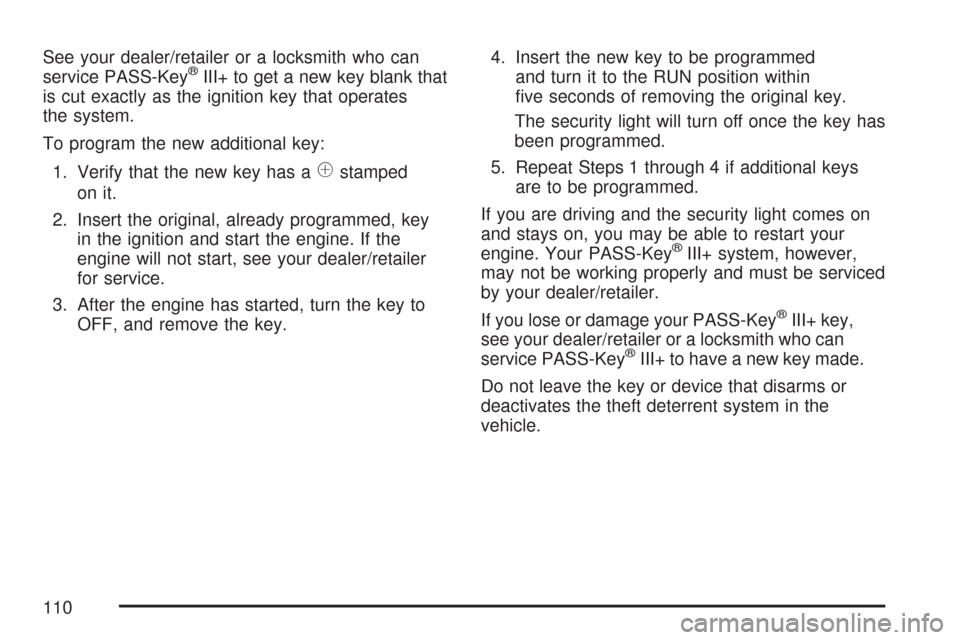
See your dealer/retailer or a locksmith who can
service PASS-Key®III+ to get a new key blank that
is cut exactly as the ignition key that operates
the system.
To program the new additional key:
1. Verify that the new key has a
1stamped
on it.
2. Insert the original, already programmed, key
in the ignition and start the engine. If the
engine will not start, see your dealer/retailer
for service.
3. After the engine has started, turn the key to
OFF, and remove the key.4. Insert the new key to be programmed
and turn it to the RUN position within
�ve seconds of removing the original key.
The security light will turn off once the key has
been programmed.
5. Repeat Steps 1 through 4 if additional keys
are to be programmed.
If you are driving and the security light comes on
and stays on, you may be able to restart your
engine. Your PASS-Key
®III+ system, however,
may not be working properly and must be serviced
by your dealer/retailer.
If you lose or damage your PASS-Key
®III+ key,
see your dealer/retailer or a locksmith who can
service PASS-Key
®III+ to have a new key made.
Do not leave the key or device that disarms or
deactivates the theft deterrent system in the
vehicle.
110
Page 112 of 460
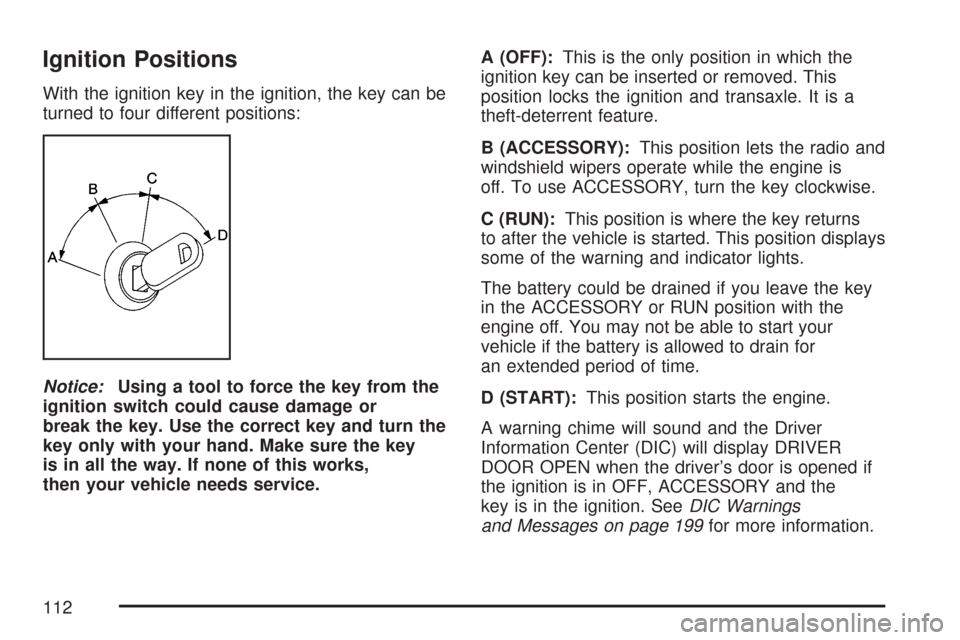
Ignition Positions
With the ignition key in the ignition, the key can be
turned to four different positions:
Notice:Using a tool to force the key from the
ignition switch could cause damage or
break the key. Use the correct key and turn the
key only with your hand. Make sure the key
is in all the way. If none of this works,
then your vehicle needs service.A (OFF):This is the only position in which the
ignition key can be inserted or removed. This
position locks the ignition and transaxle. It is a
theft-deterrent feature.
B (ACCESSORY):This position lets the radio and
windshield wipers operate while the engine is
off. To use ACCESSORY, turn the key clockwise.
C (RUN):This position is where the key returns
to after the vehicle is started. This position displays
some of the warning and indicator lights.
The battery could be drained if you leave the key
in the ACCESSORY or RUN position with the
engine off. You may not be able to start your
vehicle if the battery is allowed to drain for
an extended period of time.
D (START):This position starts the engine.
A warning chime will sound and the Driver
Information Center (DIC) will display DRIVER
DOOR OPEN when the driver’s door is opened if
the ignition is in OFF, ACCESSORY and the
key is in the ignition. SeeDIC Warnings
and Messages on page 199for more information.
112